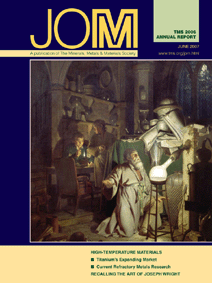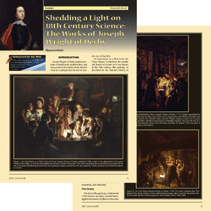INTRODUCTION
Joseph Wright of Derby painted portraits
of intellectuals, industrialists, and
an assortment of wealthy clients. But the
work he is perhaps best known for centers
on a dying bird.
An Experiment on a Bird in the Air
Pump (Figure 1) illustrates the wonder
and horror of science as it was known
in the 18th century.
|
"The bird lays in a glass
globe at the top of the painting as the
scientist withdraws air from the globe
using an air pump." |
|
The painting, as
described by the National Gallery in London, depicts a traveling scientist
who demonstrates the formation of a
vacuum, a lesson provided at the expense
of a cockatoo. The bird lays in a glass
globe at the top of the painting as the
scientist withdraws air from the globe
using an air pump. And if the sight of a
bird on the brink of death is not enough
to generate a response from onlookers,
a bowl containing a skull glows in the
candlelight that illuminates the scene.
The demonstration, conducted before
a group of men, women, and children,
inspires a gamut of reactions from fear
to disinterest, as shown in the eyes of
the onlookers.
|
EXHIBIT PORTRAYS THE ART OF WORK AND PLAY
|
Joseph Wright of Derby will be keeping good—and unusual—company in an
exhibition of various artists’ portrayals of “Work, Rest & Play.” The exhibit, organized
by The National Gallery, London, includes Wright’s An Iron Forge (Figure 6) with its
compilation of works dating from the 16th century to the present. Among the artists
featured are Thomas Gainsborough, Edouard Manet, Claude Monet, and Paul
Gauguin.
Wright’s blacksmith, whose 18th century shop is equipped to forge iron using water-powered
tilt hammers,2 will be featured with the masters as well as more modern views
of work and leisure, such as Lars Tunbjork’s photograph of a Tokyo stockbroker asleep
at his desk, and L.S. Lowry’s painting, Coming from the Mill (1930), which depicts an
army of faceless laborers in a 20th century industrial city.
According to the National Gallery, the exhibition “traces changing ideas about work
and leisure, and looks at how artists have responded to major shifts in working patterns,
from industrialization to contemporary office culture.”
The exhibition will be at the U.K.’s Laing Art Gallery, Newcastle-upon Tyne, through
July 15, and at the National Gallery, London from July 26 through October 14.
|
This painting, along with two other
striking works, A Philosopher Giving
a Lecture on the Orrery (Figure 2) and
Alchymist, in Search of the Philosopher’s
Stone, Discovers Phosphorus, and
prays for the successful Conclusion of
his operation, as was the custom of the
Ancient Chymical Astrologers, often
shortened simply to The Alchymist (Figure 3), earned Wright acclaim as a
painter of 18th century science.
Wright’s art will have greater exposure
later this year when an exhibit, focusing
on the period from 1768 to 1771,
and an accompanying symposium, will
be presented at the Walker Art Gallery
at the National Museums in Liverpool
starting in November. After the exhibit
closes in February 2008, it will travel to
the United States to be presented at the
Yale Center for British Art from May
through August.
SHEDDING LIGHT ON A REVOLUTION
Wright’s artistic inclinations were
shaped during his boyhood in Derby, a
small town that would become an epicenter
of the Industrial Revolution in central
Britain. Born in 1734, young Wright was
mechanically minded and curious, and a
frequent visitor of the shops in his town,
according to an 1885 book by William
Bemrose.1 Wright would observe the
work of the various craftsmen, and then
do his best to mimic it at home.
“This love for mechanics showed
itself later in life by the introduction of
an air-pump and an orrery into two of
his principal pictures,” Bemrose wrote.
|
"As an adult, he was drawn to an
impressive circle of friends that included
scientists, artists, and industrialists." |
|
Wright was also interested in drawing,
and when he was 17 trained formally with
Thomas Hudson, a successful portrait painter in London.2 Wright subsequently
painted numerous portraits, including
several self portraits. (Shown in Figure 4 is a self portrait at the age of about
20, provided by the Derby Museum and
Gallery.)
As an adult, he was drawn to an
impressive circle of friends that included
scientists, artists, and industrialists.
This combination of influences
resulted in dramatic paintings that
captured the mood of progress and possibility
in Britain in the 18th century.
“He’s considered one of the most
important 18th century British painters,”
said Elizabeth Barker, director of the
Picker Art Gallery at Colgate University
in New York. Barker is guest curator
of the upcoming Wright exhibition in
Liverpool and Yale. She has spent years
studying the artist, culminating in her
doctoral dissertation. Wright may not
be as well known as his contemporaries,
such as Joshua Reynolds or Thomas
Gainsborough, she said, but his work
has become more widely appreciated
beyond Derby’s borders. “Certainly his
star is in the ascendancy,” Barker said.
PHYSICS, ASTRONOMY, AND CHEMISTRY
Barker first encountered Wright’s art
when she was studying at Yale University
as an undergraduate. The Yale Center
for British Art has among its holdings
a Wright work called The Blacksmith’s
Shop (Figure 5). That painting, with its
dramatic treatment of a mundane subject,
captured Barker’s attention and she has
never lost interest.
|
"He is
perhaps best known, however, for the
three science-themed paintings that set
him apart from most artists of his time:
those of the air pump, the orrery, and
the alchemist." |
|
Wright was fascinated with the effects
of light, and many of his paintings, such
as The Blacksmith’s Shop and another,
later piece, An Iron Forge (Figure 6),
show evidence of that interest. He is
perhaps best known, however, for the
three science-themed paintings that set
him apart from most artists of his time:
those of the air pump, the orrery, and
the alchemist. Barker has studied the
paintings in the context of Wright’s times
and concluded that they were probably
intended to represent concepts of physics,
astronomy, and chemistry.
The Orrery
The first of the paintings, exhibited in
1766, features an orrery, a model showing
the movements of planets in the solar
system. A lamp in the center represents
the sun. In Wright’s composition, the
lamp is not visible, but its reflections
illuminate the faces of the audience.
It was not unusual to behold such a
scene in Wright’s time. In 18th century
Britain science was becoming popularized
with traveling public demonstrations.
Wright very likely attended such
demonstrations, according to Benedict
Nicolson, author of an extensive 1968
study of Wright.2
“He watched chemical
experiments being conducted at night in
darkened rooms,” Nicolson wrote. “On
the polished surface of the table would
be set a lamp, and as the spectators
crowded around to observe what was
happening, shadows would play on their
faces or hover menacingly on the wall
behind them, shuddering as the flame
flickered.” In his paintings, Wright was
artfully portraying the drama he saw in
bringing enlightenment to the masses,
Nicolson wrote.
The Air Pump
Like the orrery, the air pump painting
was a depiction of a science exhibition.
This one, however, is set up to inspire
suspense and sympathy along with curiosity
among the onlookers. Exhibited in
1768, the painting shows an air pump,
which the demonstrator cranks to remove
air from a glass bowl in which a bird is
sealed. One child hides her eyes, while
an older boy watches curiously on the
sidelines. A young couple gaze into one
another’s eyes, disinterested in the fate of
the bird altogether. Eerie shadows light
the faces of the onlookers, and whether
the bird is to live or die is left to the
imagination of Wright’s audience.
The scene, and the questions it suggested
about science, morality, and
enlightenment was so memorable for
John H. Lienhard that he composed
a short radio story about Wright for
his Engines of our Ingenuity program.
Lienhard, M.D. Anderson Professor
Emeritus of Mechanical Engineering
and History at the University of Houston,
writes and hosts a program for public
radio that features stories of culture and
human creativity. Episode 897 focused
on “Wright of Derby.” Lienhard said he
saw Wright as representing an exciting
time in science and humanity, when the
Industrial Revolution coincided with a
period of intellectual revolution known
as the Enlightenment.
“This whole rising up against rationalism
. . . Oh boy, you can see it in Derby,
that horrible beautiful picture of the bird
being smothered,” Lienhard said.
The Alchymist
The Alchymist, painted in 1771,
presents a scientist in a church-like lab,
stumbling onto a discovery by moonlight.
As stated in the full title, the alchemist
was seeking the Philosopher’s Stone, a
magical substance that would turn any
metal into gold. Instead, he discovers in
his flask the glow of phosphorous. The
painting places the scientist on his knees,
reverently kneeling before the glowing
substance.
|
"The painting is believed to depict the
discovery of phosphorous by Hennig
Brandt, nearly 100 years earlier." |
|
The painting is believed to depict the
discovery of phosphorous by Hennig
Brandt, nearly 100 years earlier, according
to Matthew Edwards, collections
access assistant at Derby Museum and
Art Gallery. The Derby museum holds
an extensive collection of Wright’s paintings
and other supporting materials, such
as writings by and about Wright.
CONCLUSION
Although Wright is reported to have
consulted scientific texts and diagrams
to plan The Alchymist and similarly,
The Hermit Studying Anatomy (Figure
7), Barker does not believe technical
accuracy was his primary goal. “He was
not a scientific illustrator,” she said.
“One of the things that really interests
me about Wright’s work is not so much
that his subject matter was scientific but
his whole approach to making art was
very much in keeping with his times,”
she said. “He was willing to question
preconceived notions and test new
ideas and to follow successes, and that
he was willing to do so with an almost
unparalleled rigor, I think, is very much
in keeping with his age.”
REFERENCES
1. William Bemrose, The Life and Works of Joseph
Wright, ARA commonly called “Wright of Derby,”
(London: Bemrose & Sons, 1885).
2. Benedict Nicolson, Joseph Wright of Derby, Painter
of Light (London: Paul Mellon Foundation for British
Art, 1968).
Maureen Byko is managing editor of JOM.
|










